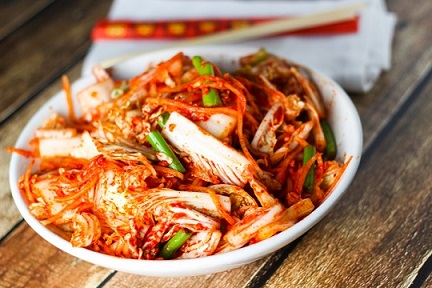If you’re into K-dramas, K-pop or even Korean otome games like Mystic Messenger, you’ll know what kimchi is. For the rest of you, salted, seasoned and fermented vegetables are classified as kimchi. Traditionally, napa cabbages and Korean radishes are used in kimchi, but with the passage of time, people started experimenting with more and more veggies to come up with their unique kimchi versions. It is seasoned traditionally with garlic, scallions, chili powder, ginger, salted seafood and sea salt.

Kimchi Health Benefits You Didn’t Know Existed
Apart from being totally delicious, did you know that there are numerous health benefitsfor you? Well if you didn’t then buckle up! We have quite a long list for you.
1. Slowing Down Your Skin’s Wrinkling Process
Most anti-wrinkle creams work on the dead skin formed on the surface of your skin. However, the antioxidants and vitamin C present in kimchi help in the regeneration of new cells from underneath your skin.
2. Good for Your Bowel Movements
Kimchi helps your bowel give smoother movements, and for those of you who didn’t know, a good bowel movement has shown to be directly connected to one’s metabolic processes.
A good bowel movement = a high rate of metabolism, and vice versa. This is why it’s great for weight loss.
3. Few in Calories
It’s a tasty meal for those who are on a diet, but are tired of eating the same bland foods day in and out. It’s especially a great option for vegans and vegetarians. It’s low in calories, high in fiber and helps keep your stomach full for long periods of time.
4. Good for Your Immunity

The seasonings in kimchi (ginger and garlic) have a high number of phenolic components and flavonoids, which help make your immune system stronger, which is literally one of the best kimchi health benefitsout there.
5. Better Digestion
Well, anything high in fiber is automatically good for your digestive system, and kimchi is no different. Fermented kimchi can be compared to yogurt, as it too contains lactobacilli (or healthy bacteria), which helps in your body’s digestive processes.
6. Assimilation of Nutrients
Often, your digestive system is filled with compounds that prevent it from functioning properly, by not letting nutrients be absorbed. However, kimchi acts as a catalyst and ensures an improved assimilation of nutrients by completely eliminating those compounds.
7. Fights off Infections
Koreans often eat kimchi on winter days or when they’re ill. That’s because unlike most homemade remedies (that are nothing but old wives’ tales), kimchi’s plethora of properties help fight viral as well as bacterial infections.
8. Good for Your Heart

Kimchi is high in two things – Selenium and Allicin, both of which have found to be good for your heart. However, if you have high blood pressure then you might need to put less (or no) salt in your kimchi, as Sodium is known to increase your BP.
9. Improves Your Skin and Hair Condition
The thing is kimchi health benefitsaren’t restricted to what’s inside your body – they include benefits for what’s on the outside too! Garlic contains selenium, which keeps both your hair and skin healthy (when consumed on a regular basis). Also, selenium is an important component of glutathione, which helps preserve vitamin C in your body, which by the way also lends to your hair and skin health.
Tips and Tricks When Making Kimchi
Now that we’ve discussed Kimchi health benefits,it’s time to move on to some helpful tips that will ensure your first time making some kimchi isn’t a complete disaster.
- Weather plays an important role: When you ferment your kimchi, you have to keep in mind the season during which you’re doing so. Winter and fall are the best seasons for fermenting, mostly because in order for the process to take place smoothly, you need a cool/low temperature. Place your kimchi in a glass mason jar, seal it tightly and keep it in a dark corner of a room, away from direct sunlight.
- Don’t go overboard with the fermentation: Longer doesn’t necessary mean better, you know. Kimchi that has been left alone for too long turns too bitter to consume. Keep tabs on your kimchi and don’t keep it aside for longer than 3 weeks. Start checking it every week to see how much it has progressed.
- Don’t let it be exposed to air: If you do so, it may pave way for white mold to grow. But don’t worry – it doesn’t mean you have to throw away your entire kimchi. Simply remove the topmost layer, and eat the rest of the kimchi like you normally would.
- Explore your options: Napa cabbage is great if you’re a first timer, but if you want variety, try regular radishes, cut green onions, spinach, onions, mushrooms and even cucumbers! Plus, the more veggies you include, the more kimchi health benefitsyou get!
- Use the right tools: A fermentation crock isn’t exactly a necessity when making kimchi. Mason jars, wooden spoons and a couple of large bowls will more than suffice.
- The paste is its USP: So don’t mess it up, will you? And don’t be shy when using your spices – go crazy. If you end up with a paste that you don’t like, then start all over again! Pepper flakes, garlic, ginger, sugar, salted shrimp, or even kelp can be added to the paste!